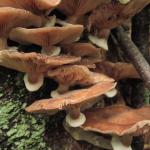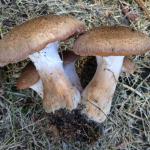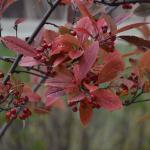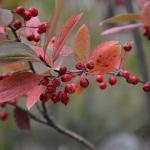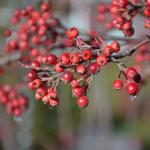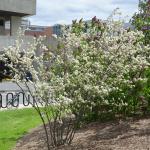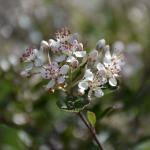A monthly e-newsletter from UMass Extension, published March to October, for home gardeners.
To read the articles in each section of the newsletter, click on the section headings below to expand the content:
Tips of the Month
October is the Month to…..
-
Do a soil test. October is the perfect month to collect soil samples for testing. Soil testing will provide you with recommendations that will enable you to promote optimal plant growth, help diagnosis nutritional issues, and potentially prevent application of nutrients that may cause environmental harm if not applied properly. For more information: ag.umass.edu/services/soil-plant-nutrient-testing-laboratory
-
Plant spring flowering bulbs. Crocuses, daffodils, hyacinths, squills and tulips should all be planted as the soil begins to cool. To get the best effect from your spring flowering bulbs; plant them in mass (hundreds) instead of just planting a couple here and there.
-
Dig summer "bulbs". Cannas, dahlias, elephant ears, gladiolus, and tuberous begonias should all be dug after the foliage receives a light frost. Dig up the roots on a dry day and instead of washing, let them air dry and lightly brush off the soil. Store in peat moss or sawdust in a location that is cool, dry and dark.
-
Plant a cover crop. As you clean up your vegetable garden, plant a cover crop in the open spaces. Cover crops help build healthy soils by recycling nutrients, building organic matter, reducing erosion, and outcompeting weeds. Oats is a good option for most home gardens - broadcast oat seed at 3 pounds/1000sqft and lightly scratch into the soil. Take cover cropping to the next level and consider using field peas or clovers to build nitrogen or use forage radishes to break up compacted soil.
-
Keep the leaves off your lawn. Fall is an important time for cool season turf grasses as they acclimate for the dormant season. Photosynthesis that occurs now helps build robust root systems and store carbohydrates that are important for a healthy lawn in the spring. Accumulating leaves on a lawn can greatly reduce photosynthesis; therefore, keep your lawn raked or use a mulching mower to mulch the leaves into the lawn.
-
Plant garlic. In most locations, garlic should be planted in October, though in the warmest areas of the state, November might be more appropriate. Garlic comes in two types: hardneck and softneck. Hardneck varieties are grown more often in the Northeast as they are often considered to be hardier. Hardnecks produce a flower scape and have stronger flavors, while softnecks have a longer storage potential and are easier to braid.
-
Use your leaves to create a great mulch. Leaves that are gathered from raking, mowing or blowing are a great resource. Instead of paying someone to haul them away, use them. Gather leaves into piles and run over them with your mower a couple of times. This chops the leaves into small pieces which makes them less susceptible to blowing away. Use the mulch liberally, 4-6 inches deep, in areas where you would traditionally use bark mulch. The chopped leaves provide a similar effect to bark mulch and are great at reducing weeds and at building soil.
Russ Norton, Cape Cod Cooperative Extension
Timely Topics
Fall Insects To Be Aware Of
Now that fall has arrived, there are several insects that may become more noticeable, bothersome, or problematic.
Stinging Insects
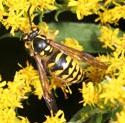 Wasps and hornets have been around all season, but, in late summer and early fall, they become more noticeable as their numbers increase and their nests have grown incrementally larger. Stinging insect nests may be located in empty tree cavities, in the ground, in railroad ties or wood piles, behind loose siding, attached to branches in trees and shrubs, etc. If these nests are disturbed by human activity such as digging into, walking or mowing near or over a ground nest, bumping or pruning into a nest in a tree or shrub, etc., the insects may be threatened and often will attack.
Wasps and hornets have been around all season, but, in late summer and early fall, they become more noticeable as their numbers increase and their nests have grown incrementally larger. Stinging insect nests may be located in empty tree cavities, in the ground, in railroad ties or wood piles, behind loose siding, attached to branches in trees and shrubs, etc. If these nests are disturbed by human activity such as digging into, walking or mowing near or over a ground nest, bumping or pruning into a nest in a tree or shrub, etc., the insects may be threatened and often will attack.
When some wasps feel threatened, they will often sting and, when they do, they release a pheromone on the victim that alerts others to attack. This pheromone is referred to as the “alarm pheromone” and it is important to run from the nest to avoid being stung repeatedly and to seek shelter immediately. Some people are sensitive to being stung and others may not know if they are sensitive or not; either way, being stung may prove to be life-threatening and medical help may be needed.
The message here is to carefully scout the area when working in the garden and landscape at this time of year. Look for stinging insect activity before pruning, digging, mowing etc. and avoid that area. Here are two information links on stinging insects:
nysipm.cornell.edu/whats-bugging-you/stinging-insects
www.youtube.com/watch?v=kFaEG86BV_o&feature=youtu.be
Deer Ticks (Blacklegged ticks) - Ixodes scapularis
 Many people are unaware that deer ticks, which are capable of transmitting several diseases, including Lyme disease, are active in the fall and usually year-round whenever the temperature is above freezing. It is important that deer tick prevention be practiced whenever working in the landscape, including in the fall during fall cleanups and planting. Deer ticks are often found in grassy areas and leaf litter, so it is important to use repellents before venturing outside and to conduct deer checks frequently after being outdoors in deer tick habitat.
Many people are unaware that deer ticks, which are capable of transmitting several diseases, including Lyme disease, are active in the fall and usually year-round whenever the temperature is above freezing. It is important that deer tick prevention be practiced whenever working in the landscape, including in the fall during fall cleanups and planting. Deer ticks are often found in grassy areas and leaf litter, so it is important to use repellents before venturing outside and to conduct deer checks frequently after being outdoors in deer tick habitat.
www.tickencounter.org
www.mass.gov/eohhs/gov/departments/dph/programs/id/epidemiology/ticks
www.capecodextension.org/wp-content/uploads/2016/04/All-About-Tick-Infograph-8.29.2017-1.pdf
Insects Seeking Shelter: Multicolored Asian Lady Beetle, Western Conifer Seedbug, Boxelder Bug, Brown Marmorated Stink Bug
As the days grow shorter and temperatures grow cooler, several insects seek warmer shelters to hibernate or overwinter. Unfortunately, these shelters are sometimes homes, office buildings, etc. and the insects may overwinter indoors and become a nuisance to people, who do not want “insect company’ in their homes. These insects may shelter out of sight in attics, window wells, etc. and sometimes on warmer days, they may become active and fly around causing consternation to the people who reside there. The insects usually seek an exit from structures in the spring once winter is over.
These insects are often seen at this time of year on the warm (south and west) sides of buildings seeking entry. These four insects do not cause damage to homes, humans, etc., they are merely seeking shelter, so the use of insecticides indoors is not usually recommended or warranted.
Instead, the recommendation is mechanical exclusion by sealing any openings (caulking windows, doors, etc.) which the insects might be able to enter through. However, these insects can slip through the tiniest of openings; if they do enter, simply remove them by gently sweeping them onto a dustpan or using a vacuum cleaner, and release them outdoors. You can also use gloves, paper towels, tissue paper, etc. and pick them up and place them outside or place them in a container and release them outside later. Several of these insects may emit an odor when disturbed, handled or crushed, so avoid handling them when possible.
Multicolored Asian Lady Beetle - Harmonia axyridis
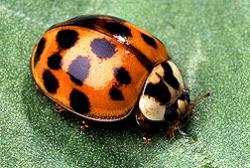 As its name implies, the multicolored Asian lady beetle is native to Asia, and looks somewhat similar to our native lady beetles, or lady bugs, that we frequently see in the landscape, except for size and sometimes color. In the US, the color of the Asian lady beetles may range from mustard to red, with 16 or more black spots. One of the major differences is size, with the multicolored Asian lady beetle often being somewhat larger than native lady beetles. Like native lady beetles, the multicolored Asian lady beetle is a beneficial insect, since both adults and larvae feed on insects, especially aphids. Here are two websites that provide more information.
As its name implies, the multicolored Asian lady beetle is native to Asia, and looks somewhat similar to our native lady beetles, or lady bugs, that we frequently see in the landscape, except for size and sometimes color. In the US, the color of the Asian lady beetles may range from mustard to red, with 16 or more black spots. One of the major differences is size, with the multicolored Asian lady beetle often being somewhat larger than native lady beetles. Like native lady beetles, the multicolored Asian lady beetle is a beneficial insect, since both adults and larvae feed on insects, especially aphids. Here are two websites that provide more information.
www.ars.usda.gov/oc/br/lbeetle/index/#life
idl.entomology.cornell.edu/files/2013/11/Multicolored-Asian-Lady-Beetle-290n55z.pdf
Western Conifer Seed Bug - Leptoglossus occidentalis
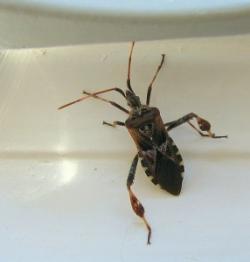 The Western conifer seed bug, native to North America, is a true bug and is sometimes referred to as one of the “leaf-footed bugs”, due to its hind legs appearing flattened and leaf-like. The adult insect, resembling a squash bug, is brownish-gray in color, is approximately ¾ of an inch long, may make a buzzing sound when it flies, and often releases a distinct, pungent odor when handled. Many people incorrectly refer to this as a stink bug, which it is not. The Western conifer seed bug usually feeds on several species of pines, hemlocks and firs. For more information:
The Western conifer seed bug, native to North America, is a true bug and is sometimes referred to as one of the “leaf-footed bugs”, due to its hind legs appearing flattened and leaf-like. The adult insect, resembling a squash bug, is brownish-gray in color, is approximately ¾ of an inch long, may make a buzzing sound when it flies, and often releases a distinct, pungent odor when handled. Many people incorrectly refer to this as a stink bug, which it is not. The Western conifer seed bug usually feeds on several species of pines, hemlocks and firs. For more information:
idl.entomology.cornell.edu/files/2013/11/Western-Conifer-Seed-Bug-2ar0tfu.pdf
Boxelder Bug - Boisea trivittata
Adult boxelder bugs are black with red markings and are approximately ½ an inch in length. Native to North America, these insects feed on Ash (Fraxinus) trees and maple trees (Acer) especially Acer negundo or Boxelder trees.
idl.entomology.cornell.edu/files/2013/11/Boxelder-Bug-1aylp9z.pdf
extension.umd.edu/hgic/boxelder-bugs-trees-and-shrubs
Brown Marmorated Stink Bug - Halyomorpha halys
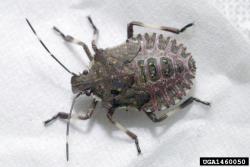 The brown marmorated stink bug (BMSB) is native to Asia, is considered an invasive species, and is a relatively new insect to the United States, probably introduced in the mid 1990’s and officially identified in 2001. It is a newcomer to Massachusetts, having been discovered in 2007 and is still not very commonly found. The BMSB feeds on a wide range of plants including vegetables, fruits and ornamentals and is considered an agricultural pest. Adults are approximately ¾ inch long, mottled brown in color, and shield-shaped. They emit a very strong odor when crushed, hence the common name stink bug. They are sometimes confused with the Western conifer seedbug. Here is a link that shows the differences: www.stopbmsb.org/stink-bug-basics/look-alike-insects
The brown marmorated stink bug (BMSB) is native to Asia, is considered an invasive species, and is a relatively new insect to the United States, probably introduced in the mid 1990’s and officially identified in 2001. It is a newcomer to Massachusetts, having been discovered in 2007 and is still not very commonly found. The BMSB feeds on a wide range of plants including vegetables, fruits and ornamentals and is considered an agricultural pest. Adults are approximately ¾ inch long, mottled brown in color, and shield-shaped. They emit a very strong odor when crushed, hence the common name stink bug. They are sometimes confused with the Western conifer seedbug. Here is a link that shows the differences: www.stopbmsb.org/stink-bug-basics/look-alike-insects
Here are other links that may be helpful:
www.epa.gov/safepestcontrol/brown-marmorated-stink-bug#bug
massnrc.org/pests/pestFAQsheets/brownmarmoratedstinkbug.html
www.massnrc.org/pests/linkeddocuments/BMSBFactSheet.pdf
massnrc.org/pests/blog/?p=848
www.stopbmsb.org/stink-bug-basics/look-alike-insects
It should be reiterated that these four nuisance insects which seek shelter in the fall do not harm people or property. For many people, these insects are unattractive and a nuisance and several of these insects do “stink” when handled or crushed. However, annoying as they may be, these insects usually do not warrant control by insecticides indoors.
Deborah C. Swanson, Horticulturist
News for Gardeners
UMass Garden Calendar Photo Contest
Ever take a great garden photo and think “this would be perfect for the UMass Garden Calendar?” We're holding a photo contest for the 2019 UMass Extension Garden Calendar, so have your camera handy and keep an eye out for contest-worthy pics! The deadline for submitting pictures is April 1, 2018. Submission details are at https://ag.umass.edu/landscape/publications-resources/garden-calendar/garden-calendar-photo-contest.
Fantastic and Self-Defended Caterpillars
The immature insects that are frequently referred to as caterpillars primarily include species in the Lepidoptera (butterflies and moths) and Hymenoptera (specifically, sawflies) families. A gardener becomes well acquainted with the caterpillars of many of the sawflies, moths, and butterflies when trying to determine “who” has been munching on the leaves of their prized plant(s) in the landscape or just by being in the right place at the right time. While some of the larval sawflies can be serious pests of landscape trees and shrubs, we'll focus here on a handful of species of butterflies and moths that have been spotted and reported in Massachusetts in August and September. According to Caterpillars of Eastern North America by David L. Wagner, close to 13,000 species of butterflies and moths occur north of Mexico, with approximately 5,000 of those occurring east of the Mississippi River. The few species discussed here are natives found in Massachusetts and they employ fascinating mechanisms for self-defense.
Looking Like Bird Droppings and Hidden Osmeteria

The above title may sound like a really good insult, but mimicking the droppings of a bird allows some species of caterpillar the luxury of hiding in plain sight. What self-respecting predator wants to eat bird excrement anyway? The very young caterpillars of the eastern black swallowtail (Papilio polyxenes) are bird dropping mimics. They are mostly black with a white “saddle” or marking that lends itself to providing the aforementioned camouflage. Older caterpillars of this species, also referred to as parsleyworms due to their favored host plants, are arguably more attractive. As seen in these photos, these caterpillars are mostly green with black stripes and yellow spots. Caterpillars of this species often feed on cultivated carrots, dill, and parsley. This insect is one of the most common and most studied swallowtails in North America. It is found in southern Canada, the eastern and mid-western USA, further west  to the Rocky Mountains, and into northern Mexico. Because this insect shares the same palate for certain cultivated items such as herbs found in our gardens, there are some who may view these gorgeous caterpillars as pests. They have tachinid fly and hymenopteran (wasp) parasitoids as natural enemies. The adult butterfly is one of our largest and arguably one of our most attractive insects. When at all possible, resist the urge to kill or remove parsleyworms. These caterpillars are typically not in large enough numbers to truly cause a problem. If you do grab a mature parsleyworm caterpillar, be prepared for the osmeterium. This is a brightly colored, often orange-yellow organ that the larva will protrude from its first abdominal segment in a defensive display. The osmeterium is not harmfule but is often coated in a smelly chemical deterrent that the insect attempts to coat the assailant with in self-defense.
to the Rocky Mountains, and into northern Mexico. Because this insect shares the same palate for certain cultivated items such as herbs found in our gardens, there are some who may view these gorgeous caterpillars as pests. They have tachinid fly and hymenopteran (wasp) parasitoids as natural enemies. The adult butterfly is one of our largest and arguably one of our most attractive insects. When at all possible, resist the urge to kill or remove parsleyworms. These caterpillars are typically not in large enough numbers to truly cause a problem. If you do grab a mature parsleyworm caterpillar, be prepared for the osmeterium. This is a brightly colored, often orange-yellow organ that the larva will protrude from its first abdominal segment in a defensive display. The osmeterium is not harmfule but is often coated in a smelly chemical deterrent that the insect attempts to coat the assailant with in self-defense.
A perhaps more convincing bird dropping mimic, the caterpillars of Papilio cresphontes are the immature stage of the giant swallowtail butterfly. This insect is widely distributed throughout the United States and much of North, Central, and South America. Host plants include members of the Rutaceae (citrus) family, including but not limited to prickly ash (Zanthoxylum spp.), torchwood (Amyris spp.), and hoptree/wafer ash (Ptelea trifoliata). The caterpillars pictured here 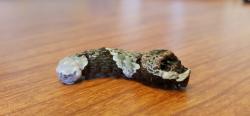 were collected from wafer ash on 9/21/17 in Amherst, MA. These caterpillars may partially defoliate small, potted plants but are otherwise not problematic. They may be considered minor pests in certain Citrus spp. crops. The adult butterflies of this species sip nectar from flowering plants such as azalea, Japanese honeysuckle, goldenrod, and swamp milkweed but can be common to many flowering plants. The adult butterfly is quite the attractive swallowtail; however, these caterpillars can be appreciated as well. Commonly referred to as the orange dog caterpillar (or orange puppy depending on who you ask), these larvae possess iridescent
were collected from wafer ash on 9/21/17 in Amherst, MA. These caterpillars may partially defoliate small, potted plants but are otherwise not problematic. They may be considered minor pests in certain Citrus spp. crops. The adult butterflies of this species sip nectar from flowering plants such as azalea, Japanese honeysuckle, goldenrod, and swamp milkweed but can be common to many flowering plants. The adult butterfly is quite the attractive swallowtail; however, these caterpillars can be appreciated as well. Commonly referred to as the orange dog caterpillar (or orange puppy depending on who you ask), these larvae possess iridescent
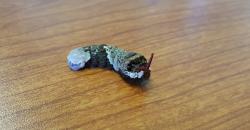
sapphire-blue spots and defense-related patterns: bird dropping-like markings coupled with what some call snake-mimicry. Scale-like markings, like those of a snake, can be seen on more mature caterpillars near the thorax. But perhaps the most impressive defense mechanism of all is the bright red osmeterium that the caterpillar will exude when irritated. This structure may look like the forked tongue of a snake, but it is again a gland that contains a mixture of chemicals that produce a putrid smell but is not harmful. This pungent aroma has been described by some as similar to that of “rancid butter”. The aroma is certainly unpleasant and surprisingly strong in this particular species.
Irritating Hairs, Spines, and Warning Coloration
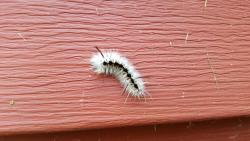 The caterpillars of the hickory tussock moth are easily recognizable. Unlike the two species discussed above, they are occasionally able to strip trees of their leaves, perhaps due to the larger number of eggs laid together. Lophocampa caryae is native to southern Canada and the northeastern United States. There is one generation per year. Overwintering occurs as a pupa inside a fuzzy, oval shaped cocoon. Adult moths emerge approximately in May and their presence can continue into July. Females will then lay clusters of 100+ eggs together on the underside of leaves. Females of this species can fly; however, they have been called weak fliers due to their large size. When first hatched from their eggs, the young caterpillars will feed gregariously in a group, eventually dispersing and heading out on their own to forage. Caterpillar maturity can take up to three months and color changes occur during this time. These caterpillars are essentially white with some black markings and a black head capsule. They are very hairy, and should not be handled with bare hands as sensitive individuals can have skin irritations or rashes (dermitis) as a result of interacting with hickory tussock moth hairs. By late September, the caterpillars create their oval, fuzzy cocoons hidden in the leaf litter where they overwinter. Hosts whose leaves are fed upon by these caterpillars include but are not limited to hickory, walnut, butternut, linden, apple, basswood, birch, elm, black locust, and aspen. Maple and oak have also been reportedly fed upon by this insect. Several wasp species are parasitoids of hickory tussock moth caterpillars.
The caterpillars of the hickory tussock moth are easily recognizable. Unlike the two species discussed above, they are occasionally able to strip trees of their leaves, perhaps due to the larger number of eggs laid together. Lophocampa caryae is native to southern Canada and the northeastern United States. There is one generation per year. Overwintering occurs as a pupa inside a fuzzy, oval shaped cocoon. Adult moths emerge approximately in May and their presence can continue into July. Females will then lay clusters of 100+ eggs together on the underside of leaves. Females of this species can fly; however, they have been called weak fliers due to their large size. When first hatched from their eggs, the young caterpillars will feed gregariously in a group, eventually dispersing and heading out on their own to forage. Caterpillar maturity can take up to three months and color changes occur during this time. These caterpillars are essentially white with some black markings and a black head capsule. They are very hairy, and should not be handled with bare hands as sensitive individuals can have skin irritations or rashes (dermitis) as a result of interacting with hickory tussock moth hairs. By late September, the caterpillars create their oval, fuzzy cocoons hidden in the leaf litter where they overwinter. Hosts whose leaves are fed upon by these caterpillars include but are not limited to hickory, walnut, butternut, linden, apple, basswood, birch, elm, black locust, and aspen. Maple and oak have also been reportedly fed upon by this insect. Several wasp species are parasitoids of hickory tussock moth caterpillars.
The caterpillars of the giant leopard moth (Hypercompe scribonia) seem to be the embodiment of the phrase: "GO AWAY". This species is native to New England with a large geographic range from southern Canada to Florida. One could argue that they are in their own way 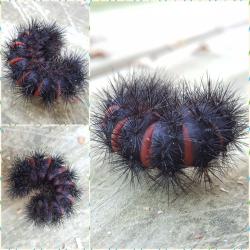
beautiful. Sharp, stiff bristles or spines provide physical protection, especially when the caterpillar is disturbed, which causes the insect to roll into a defensive position. Once curled up, as seen in these photos, the red rings between the segments of the body become visible. The spiracles, or external respiratory openings, of these caterpillars are also red in color. These bold markings suggest to the onlooker that this caterpillar is also chemically protected (meaning they would be distasteful or potentially poisonous if consumed by a predator). These larvae feed on both woody and non-woody plants, including but not limited to cherry, willow, oak, plantain, sunflower, violet, and dandelion, although the feeding damage they cause does not warrant management. As was the case with this individual found in Hampshire County, MA on 9/23/17, the nearly fully-grown caterpillars of this species are frequently encountered by people raking leaves or busy with fall cleanup of landscaped areas. These caterpillars overwinter in sheltered areas such as leaf litter, under logs, or beneath loose bark.
If you are interested in learning more about the caterpillars of butterflies and moths, the aforementioned field guide, Caterpillars of Eastern North America by David L. Wagner is a beautifully illustrated text with great information. Online resources abound, including the Lepidopterists’ Society (www.lepsoc.org), the North American Butterfly Association (www.naba.org), the Massachusetts Butterfly Club (www.naba.org/chapters/nabambc/index.asp), and the Butterflies and Moths of North America (www.butterfliesandmoths.org).
Tawny Simisky, UMass Extension Entomologist
Trouble Maker of the Month
Armillaria Root and Butt Rot
Armillaria is a soilborne, root and lower trunk rot pathogen that will preferentially attack trees weakened by stress. Insect defoliation (e.g. gypsy moth and winter moth) along with the 2016 drought weakened many landscape trees in the region, creating ideal conditions for Armillaria to initiate and expand current infections.
Armillaria produces annual, fleshy mushrooms during brief periods in the fall, when conditions are cool and wet. Spores are disseminated and can initiate new infections on open basal wounds. Mushrooms are most abundant from late September through early October in our region. Rhizomorphs (black, root-like structures present in the soil) grow and expand starting in late spring and into the fall. They can be found attached to large, lateral roots just below the soil line.
Symptoms of armillaria root rot can be very general. Infected trees and shrubs will show dieback of upper canopy branches, a stress cone or seed crop, basal flaring, resin/sap flow at the base, basal cankers (butt rot), and scorched or blighted foliage. Rhizomorphs will be present below the soil, attached to roots on the base of the tree. On badly infected trees, white mats of fungal tissue, known as mycelial fans, may be present beneath the bark on the cambium.
If a tree is known to be infected with Armillaria, reduce additional stresses at all costs. Avoid fertilization, as the fungus will also be stimulated. Lime can be applied to increase vigor of sugar maples. Prune out dead branches that pose a hazard risk. Carefully monitor the tree going forward as Armillaria can cause significant internal decay that cannot be detected from a visual assessment along, leading to possible stem failure.
Plant of the Month
Aronia arbutifolia ‘Brilliantissima’, Chokeberry
Looking for a native shrub with great fall color to replace the invasive Euonymus alatus (burning bush)? Aronia arbutifolia ‘Brilliantissima’ is a great multi-season interest plant for shrub borders, woodland, naturalized, and wet areas.
Aronia arbutifolia ‘Brilliantissima’ has an upright multi-stemmed form growing 6-8’ tall and 3-4’ wide. Corymbs of small, white five-petaled flower emerge in early May and last around one week. Flowers are followed by clusters of ¼” glossy red fruits (pomes) that ripen in late summer and persist into fall and winter. Leaves are small (1.5-3.5” long), ovate, dark glossy green with serrations and pubescent gray-green undersides.
Aronia arbutifolia ‘Brilliantissima’ has great, bright-red fall color, sometimes having a mix of red, purple, and orange. Chokeberry is best planted in groups and with other plants as these shrubs can be leggy. ‘Brilliantissima’ is considered to be superior to the species for having more intense red fall color, larger and more abundant fruit, and a more compact habit. It is also more commonly available in nurseries than the species.
Best fruit production and flowering occurs in full sun but plants are tolerant of part shade. Aronia arbutifolia is an adaptable plant, tolerating both wet and dry soil. Birds tend not to eat the fruit due to the bitter taste. This plant is a good choice for naturalistic, native, or rain gardens.
Mandy Bayer, Extension Assistant Professor of Sustainable Landscape Horticulture, University of Massachusetts Amherst
Additional Resources
Landscape Message - for detailed timely reports on growing conditions and pest activity
Home Lawn and Garden Resources
Find us on Facebook! https://www.facebook.com/UMassExtLandscape/
Follow us on Twitter for daily gardening tips and sunrise/sunset times. https://twitter.com/UMassGardenClip
Diagnostic Services
The UMass Extension Plant Diagnostic Lab provides, for a fee, woody plant and turf disease analysis, woody plant and turf insect identification, turfgrass identification, weed identification, and offers a report of pest management strategies that are research based, economically sound and environmentally appropriate for the situation. Accurate diagnosis for a turf or landscape problem can often eliminate or reduce the need for pesticide use. Sampling procedures, detailed submission instructions and a list of fees.
The UMass Soil and Plant Nutrient Testing Laboratory at the University of Massachusetts Amherst provides test results and recommendations that lead to the wise and economical use of soils and soil amendments. The Routine Soil Analysis fits the needs of most home gardeners. Sampling procedures plus the different tests offered and a list of fees.
Spread the Word!
Share this newsletter with a friend! New readers can subscribe to our Home Gardener E-Mail List.
